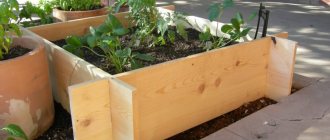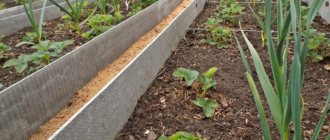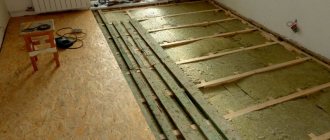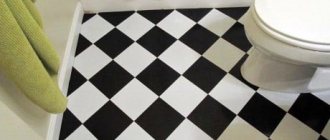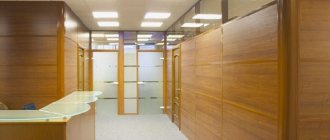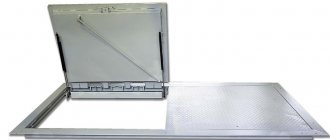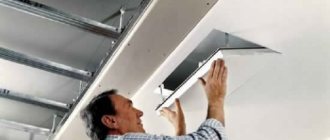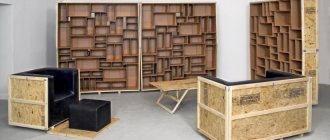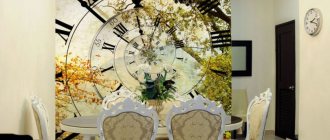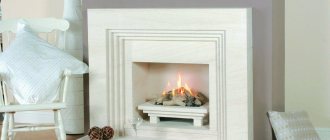Asbestos-cement slate is not often used for fencing the site. The habit of using it according to the “residual principle” served it as a bad advertisement. Many dacha owners put old slate roofing, covered with moss and nail holes, on their fences. Their neighbors, looking at its unpresentable appearance, choose other fencing options.
If you approach the matter wisely, without trying to save on the fence due to an outdated roof, then slate can successfully compete with other types of sheet materials.
Our goal in this article is to consider the advantages, features and examples of slate fences. We hope that after reading them, many readers will change their attitude towards this material.
Characteristics, pros and cons of slate
Depending on the raw materials used, it differs in structure, shape, and working properties.
Users often search for:
- Construction of a fence from slab
- Fence made of plastic panels
Let's look at each type in detail.
Asbestos-cement
Standard slate. Suitable for both roof and fence. The sheets are produced by pouring a mixture of asbestos, cement and water into molds. Asbestos fibers create a strong mesh that increases the strength and resistance of the material to stress. Available flat or wavy.
Photo: using asbestos-cement slate to fence the area
Among the important advantages of using sheets for the construction of a slate fence it is worth noting:
- Long service life. On average, unpainted material is 30 years old, painted material is 50 years old.
- Frost resistance. Asbestos cement is not afraid of temperature changes.
- Ability to withstand loads (one element – up to 70 kg).
- Strength. Does not deform under the influence of moisture or temperature.
- The material does not rot or rust.
- Low price compared to corrugated sheets and concrete sections.
- Easy installation. It can be done by one person.
- If you properly decorate a slate fence, then in terms of aesthetics it will not be inferior to a brick or metal structure.
The downside is fragility. When dropped, the sheets crack or break into pieces. Once damaged, wavy elements cannot be repaired, while flat ones can be reconstructed using metal plates.
In addition, when cutting slate, caustic asbestos dust is released, which is harmful to the respiratory system. Therefore, you need to work in a protective mask or respirator.
Slate
Natural material. It looks like stone plates of different sizes. Most often used when arranging roofs.
Photo: the roof of the southern house is made of natural (slate) slate
For fences it is used as an auxiliary material when it is necessary to decorate concrete or combined sections. It is durable, resistant to environmental influences, and does not require additional finishing.
Other types
On the building materials market you can find:
- Plastic slate. The basis is high-quality polymer. Has different degrees of light transmission. It is used for roofing and walls in summer gazebos and greenhouses. In addition to the metal frame it will become a beautiful fence.
- Euroslate. This name was given to Ondulin, Aqualine, Nulin and other roofing materials. They have different production technologies, but each type is based on polymer and pressed cellulose. Waterproof. Not used for fence construction.
- Rubber. Composition: recycled rubber, fiberglass waste. Obtained by pressing. Has light weight and high strength. It is rarely used for the construction of fences, more often for roofing.
Photo: polycarbonate fencing
There are other types of slate, but when planning the construction of a fence, you should choose asbestos-cement slate. The design will be inexpensive, it will be easy to make even by one person, and if painted correctly, it will look beautiful.
Is asbestos cement harmful?
Recently, there has been a lot of noise and conflicting information around materials containing asbestos. Are they safe, can they be used in private construction?
According to the IARC (International Organization for Research on Cancer) classification, asbestos fiber is recognized as a category 1 carcinogen. The harmful effects of asbestos on humans have been scientifically proven in tests. But why then are slate and other building materials containing carcinogens still produced?
The ancient Greeks called asbestos mountain flax. The mineral’s structure resembles bundles of plant threads, but unlike them, it consists not of organic matter, but of silicate compounds. It does not burn, has high strength and chemical resistance.
There are 2 types of asbestos in nature:
- chrysotile - mined in Russian deposits;
- amphibole - mainly in the USA, it is not in Russia.
By the way, the second variety is prohibited for use in the European Union. Amphibole fibers are quite fragile and consist of needle-shaped crystals loosely bound together. Weak ties break easily. When inhaled, tiny particles enter the respiratory system and cause irreparable harm. This type of asbestos is recognized as the most carcinogenic.
Chrysotile asbestos, unlike amphibole asbestos, has a tubular structure. The fibers are connected into bundles and practically do not disintegrate. In addition, in slate, asbestos is surrounded by cement mortar, which firmly holds it in the material. Thus, the carcinogenic effects of pure chrysotile are completely neutralized by the shell.
The following are produced from asbestos:
- corrugated and flat sheets for roofing, fences, facade cladding;
- insulation;
- pipes;
- sealants, adhesives;
- technical rubber products;
- concretes, mortars.
Asbestos-containing materials are not used for interior decoration. Their area of application is mainly outdoor work.
Types of sheets: sizes, performance properties, cost
A homogeneous mixture of asbestos, cement and water is placed in molds and pressed, and then dried under high temperatures.
The result is wavy or flat slate. Let's look at the nuances of each material.
Flat
In accordance with GOST 18124–95, such sheets are:
- Pressed (LP-P). It has a high level of strength - 23 MPa (kgf/cm3), which is several times more than the second type. Impact strength – 2.5 kJ/sq. m. Heavy in weight. Frost-resistant. To obtain a reliable structure, it is recommended to install a fence made of flat pressed slate.
- Unpressed (LP-NP). In many technical characteristics it is inferior to pressed ones. The bending strength does not exceed 18 MPa. The only advantages are light weight and low price.
The most popular sheet sizes are:
- 2*1.5 m;
- 1*1.5 m;
- 3*1.5 m.
Thickness from 6 to 10 mm.
The use of flat slate requires the construction of a reliable foundation and fasteners. The average price is 700-800 rubles. for 1 sheet.
Installation to poles is carried out in two ways:
- The sheets are fixed in a frame made of steel angle.
- They are drilled into horizontal joists made from metal profile pipes.
The first option is considered more durable, since the frame protects the edges of the sheet from damage. At the same time, the slate remains solid without holes. The frame must be secured to the supports by welding.
The second option is simpler. Using a similar technology, the installation of wavy elements is carried out.
Wave
Available in three types:
- IN. Wave sheet with a regular profile. Length – 112 cm, width – 68 cm. Used for arranging the roof of buildings no more than 15 m high.
- VU. Reinforced wave. Length – 280 cm, width – 100 cm. It is used as a facing material for roofs of manufacturing and industrial enterprises.
- UV. Unified wave. Length – 175 cm, width – 112.5 cm. It is considered universal, since it is used both for the roofing of private houses, industrial areas, and for various types of fences.
The unified sheet profile is considered the best for a reliable fence made of wave slate, since it has a high density and a convenient working width.
The minimum weight of 1 sheet is 18.5 kg, the maximum is 26 kg, thickness is up to 7.5 mm.
Running slate dimensions:
- 1.75*1.125 m for 8 waves;
- 1.75*0.98 for 7 waves.
The average price of a standard sheet is from 200 rubles.
The elements are fastened to metal or wooden logs. In this case, the pillars can be made of different materials.
Often they buy colored sheets that do not need finishing, but cost at least 50% more than standard ones.
People are also reading: Wave Slate Beds.
Pillars
The supports must be strong, stable, and able to withstand loads from snow, wind and the weight of the sections. Each pillar can stand alone or be connected to the rest with a strip foundation.
Metal round or profile pipes
They are durable, lightweight, easy to install, and are not afraid of critical temperatures. Installed by concreting or driving into the ground.
The main task of the builder is to protect the metal from corrosion. It is recommended to treat the part that will be in the ground with mastic, and cover the upper part with durable paint. On sale you can find ready-made systems of supports, crossbars and fasteners. But they do not always correspond to the required sizes, and they are also expensive.
On heaving and marshy soils, screw piles can be used as supports. They hold well in the ground and are not subject to seasonal movements. Installation is done manually using a collar, which is attached to the pile head.
Wooden
Suitable for dry permeable soils with low groundwater level. With regular treatment against rotting, the supports last quite a long time. For production, logs or beams are used, the bottom of which is coated with bitumen mastic and wrapped with roofing felt.
You can pre-burn the base of the pillars with a blowtorch. Heat treatment compacts the wood, which prevents moisture from penetrating inside.
From asbestos cement pipes
Such supports are durable, do not rot, and are not afraid of moisture. Their only drawback is fragility. Water that gets inside in winter can rupture the walls of the pipe, which will lead to the destruction of the fence. If you fill the pipe with concrete or install a protective cap, these troubles can be avoided.
Asbestos-cement pipes do not resist deformation well, so it is recommended to install wood veins. They do not react as sensitively to temperature fluctuations as metal ones, and the supports are less affected.
Step-by-step installation of a slate fence with your own hands
The construction instructions are in many ways similar to the construction of a fence made of corrugated sheets, but there are still differences in the set of tools, the order of fastening, and the finishing of sheets.
A cost estimate is prepared in advance and the total cost of the work is calculated.
When using old slate, it is recommended to clean it of moss and dirt particles in advance.
The location of the future structure is selected correctly, taking into account the requirements of SNiP, so that in the future there will be no disagreements with neighbors.
Slate fence layout: section width 2500 mm, frame height 1800 mm, sheet height 2000 mm, post driving depth 1200 mm.
Necessary materials, tools
Their list is as follows:
- sheets of flat slate;
- main and intermediate pillars (preferably metal) with a cross section of 80–120 mm;
- steel corner measuring 50*50 mm (for 1 support you will need 2 pieces of corner, 250 mm each);
- cross beams from edged boards 50*130 mm or profile pipe;
- cement grade M 500;
- bolts 70–80 mm long;
- galvanized self-tapping screws with 50 mm washer;
- bitumen mastic;
- bayonet shovel, hand drill;
- level;
- welding machine, mask, electrodes;
- plumb line;
- electric drill;
- concrete mixer or construction mixer;
- wrench 10–22 mm;
- hacksaw for metal;
- grinder with a disc for concrete, metal;
- container for mixing solution and water.
Safety precautions should not be neglected. Work should be carried out in special clothing; when cutting sheets into pieces, wear a respirator and an eye mask.
Marking, foundation
After preparing the tools and materials, you need to move on to cleaning the surface of the earth at the construction site from plants, roots, and debris. Excess soil can be taken by wheelbarrow to the garden.
The foundation is selected not only according to the load. The relief features of the site play an important role.
It is allowed to install both a strip and columnar foundation and other foundations under a slate fence.
You will find step-by-step instructions on the construction of various types of strips here: “Types of strip foundations and the technology of their construction.”
We recommend that you read:
- How to concrete fence posts
- Making a foundation for a fence
Installation of pillars
Wooden or metal supports are often chosen for corrugated slate, and metal supports for flat sheets.
In rare cases, concrete pillars are erected and installed.
Wood is preferred when the fence is assembled from used sheets. Read more about installing wooden poles.
For durable fencing, choose poles made of metal, attaching other elements to them by welding.
The recommended installation step for supports, regardless of the type chosen, is 2–2.5 meters.
Attaching the log
Let's give an example of an inexpensive fence option - fixing wooden logs to metal posts.
Work order:
- We prepare the required elements immediately after pouring the foundation. Then there will be no downtime.
- We cut the steel corner with a grinder into strips 200–250 mm long.
- We drill holes along the edges to make it convenient to attach logs from timber.
- We weld the planks to the supports in two places: with a distance of 200 mm from the top and from the bottom.
- We treat the timber for the logs with an antiseptic. It is recommended to take a cross section of 50*130 mm.
- Drill holes through in the prepared areas. We fix the beam to the supports with coupling bolts.
If you use profile pipes for fastening, then the procedure is performed both with and without a steel corner, only by welding.
Installation of sheets
Fastening of flat sheets is carried out in a pre-prepared frame of steel corners.
There is an alternative option, more popular and simpler, but it is inferior in reliability. Suitable for wave and flat slate.
The order is as follows:
- The sheet is laid on horizontal logs. Verticality is checked.
- Fastening elements - galvanized self-tapping screws with rubberized washer. The fixation step is at least 30 cm.
Scheme for fastening slate sheets: 1 – sheathing, 2 – slate, 3 – screw or nail, 4 – metal washer, 5 – rubber gasket. - When installing, builders advise making a retreat from the soil of at least 10 cm.
- The wave slate is fixed through the peak of the wave. When joining, the top of the wave of one sheet is superimposed on the peak of the wave of the other sheet.
If you need to cut the sheet into pieces, you should moisten it with water beforehand so that less asbestos dust is released during cutting.
Tools
For normal continuous work on installing a fence, you need to acquire an angle grinder, a drill, a welding machine, a set of wrenches, a building level, a plumb line, a construction hammer and a cord.
As for the materials, take care in advance of having the required type of slate, steel corners 5x8.5 centimeters, steel pipes from which the posts will be made, wooden beams 5x13 centimeters, wooden round logs, bolts, nuts, fasteners, hex screws, concrete, oil paint, bitumen and anti-corrosion compounds.
How to paint the fence, choice of paint coating
Slate processing provides the following advantages:
- extends the service life of sheets, prevents cracks;
- the surface does not collect dust and looks smoother;
- you can give the fence the color you want, the degree of dullness;
- protects slate from the formation and development of moss and lichen;
- the fence looks nicer.
You need to choose paints and varnishes carefully, since not all compositions are suitable for treating slate surfaces.
Among the recommended products it is worth noting:
- alkyd;
- acrylic;
- silicone (organosilicon);
- enamel of the “liquid plastic” type.
For pre-treatment, special protective primers are used. You need to choose them so that they are compatible with the paint.
It is worth noting that when using most paints, priming is not necessary, with the exception of acrylics.
This type is considered the best for slate surfaces despite its high cost. It protects against fading and creates a protective film.
Primer and paint are applied with any convenient tool:
- roller;
- brush;
- spray gun.
Popular colors are:
- brown;
- green;
- red.
But if the desired tone is not available ready-made, you can apply tinting, that is, add a tinting dye of the desired shade to the purchased paint, which is purchased separately. It is better to mix using a construction mixer.
Preparing for the construction process: calculating the area
It is necessary to prepare the perimeter of the fenced area: clear it of obstacles, construction and natural debris.
Demarcate (mark) the installation site. Drive pegs into the corners of the fenced area and stretch twine between them.
Land surveying
Use a tape measure or other measuring device to determine the length. The resulting numerical value (linear meters) is the main parameter that is necessary to make all the necessary calculations.
Advice! In order to measure the perimeter as accurately and quickly as possible, you need to remove the stretched twine from the pegs and wrap it around a half-meter board. The number of full turns of the cord on the board will correspond to the number of linear meters.
How to paint slate correctly
The product consumption per linear meter depends on the chosen application method (brush, roller, spray gun). Approximate figures are always indicated by the manufacturer on the packaging.
It is recommended to apply the paint in two layers:
- Base. The entire surface including ends, joints, and corners is painted.
- Finishing. Apply after the first one has dried. Gives the structure a uniform, uniform color.
If necessary, the number of layers can be increased, but whether to do this or not is up to you to decide.
Video description
How to properly build a strip foundation for a fence is shown in this video:
See also: Catalog of companies that specialize in the construction of fences and enclosures
On a note! Over time, slate slabs can be replaced with corrugated sheets.
To build a foundation, you need to dig a trench around the entire perimeter of the site, with a depth of more than 0.8 m and a width of 0.2 m to 0.4 m (this figure depends on the thickness of the support, the tape should exceed it 2 times).
The walls of the trench are lined with formwork. A drainage layer of sand and gravel is laid at the bottom of the pit. The prepared pillars are installed around the perimeter at the designated points. The vertical direction is checked by plumb line. After this, the trench is filled with cement mortar. The concrete foundation can be raised above ground level by 20-30 cm.
High strip foundation Source vizit-zabor.ru
Decorating the fence
You can decorate a fence not only by painting it one color.
Many owners purchase ready-made colored sheets of contrasting tones, alternating them with each other. Due to this, the structure turns out to be more vibrant and interesting.
Multi-colored ornaments and landscapes look beautiful on slate. Such a fence will have no analogues and will become a real work of authorship.
Decoration option with stone is allowed. But this is an expensive solution and is rarely used by owners.
Calculation of the required quantity: examples, drawings
After the dimensions of the area have become known and the type of future material has been determined, it is necessary to calculate the number of asbestos sheets. If with a flat one, everything is relatively clear - you can join, then with a wavy one, not everything is so clear.
Fence drawing
In order to accurately calculate the number of wavy ones, you need to take into account the fact that they do not fit together, but overlap each other, i.e. overlapped. Therefore, the quantity will be determined by the ratio of the perimeter length to the sheet minus the distance of one wave in each butt overlap (150 or 200 mm).
Photo gallery
The photo below shows different ways of installing slate sections and interesting ideas for decorating such structures.
Despite the fact that slate is not so popular when constructing fences, with a creative approach the design will turn out to be reliable and beautiful. At the same time, expenses from the family budget will be minimal.
Step-by-step instruction
Construction order:
- marking the territory using pegs and twine;
- marking and drilling holes for support pillars and (or) digging trenches for strip foundations, as well as installation of formwork;
- concreting pillars and (or) formwork;
- installation of horizontal crossbars between pillars;
- hanging slate sheets;
- finishing.
Project


